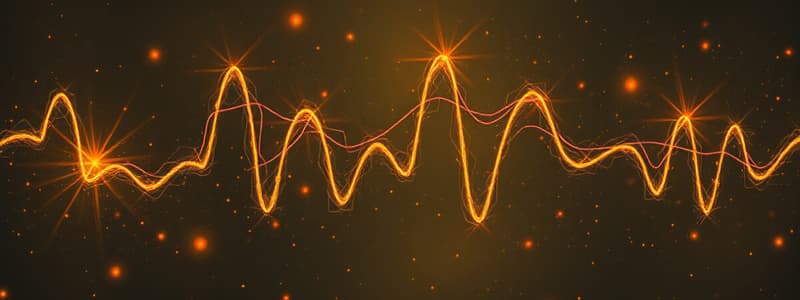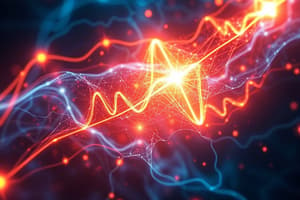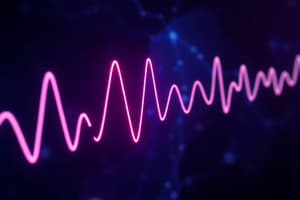Podcast
Questions and Answers
What is the process called when multiple subthreshold potentials are added together to reach the threshold for an action potential?
What is the process called when multiple subthreshold potentials are added together to reach the threshold for an action potential?
- Spatial Summation
- Temporal Summation (correct)
- Repolarization
- Hyperpolarization
During the depolarization stage of an action potential, which gates open quickly?
During the depolarization stage of an action potential, which gates open quickly?
- K+ activation gates
- Na+ activation gates (correct)
- Ca2+ activation gates
- K+ inactivation gates
What occurs once the sodium inactivation gates are closed?
What occurs once the sodium inactivation gates are closed?
- Hyperpolarization is eliminated.
- An action potential can be generated immediately.
- The membrane depolarizes further.
- The membrane returns to resting potential. (correct)
Which phase involves the membrane potential becoming more negative as potassium ions rush out of the cell?
Which phase involves the membrane potential becoming more negative as potassium ions rush out of the cell?
What is the resting membrane potential typically measured at?
What is the resting membrane potential typically measured at?
What defines the absolute refractory period?
What defines the absolute refractory period?
Which statement is true regarding the inactivation gates of Na+ during an action potential?
Which statement is true regarding the inactivation gates of Na+ during an action potential?
What change occurs during the relative refractory period?
What change occurs during the relative refractory period?
What occurs during the hyperpolarization phase?
What occurs during the hyperpolarization phase?
How does accommodation affect the membrane?
How does accommodation affect the membrane?
Which type of summation occurs when two or more presynaptic inputs arrive simultaneously from multiple sources?
Which type of summation occurs when two or more presynaptic inputs arrive simultaneously from multiple sources?
What is the main factor that increases action potential conduction velocity?
What is the main factor that increases action potential conduction velocity?
What initiates an action potential in the axon hillock?
What initiates an action potential in the axon hillock?
At the peak of the action potential, which of the following is true of the K+ activation gates?
At the peak of the action potential, which of the following is true of the K+ activation gates?
What happens to the sodium channels during the action potential phase?
What happens to the sodium channels during the action potential phase?
What is the role of the nodes of Ranvier in nerve conduction?
What is the role of the nodes of Ranvier in nerve conduction?
What characteristic best describes skeletal muscle cells?
What characteristic best describes skeletal muscle cells?
What is the primary role of nebulin in skeletal muscle?
What is the primary role of nebulin in skeletal muscle?
Which protein serves as the structural anchor for thick myosin filaments?
Which protein serves as the structural anchor for thick myosin filaments?
What defines a sarcomere in muscle tissue?
What defines a sarcomere in muscle tissue?
What is primarily contained in the H zone of a sarcomere?
What is primarily contained in the H zone of a sarcomere?
Which component of skeletal muscle is responsible for regulatory functions during contraction?
Which component of skeletal muscle is responsible for regulatory functions during contraction?
What characterizes the A band in skeletal muscle?
What characterizes the A band in skeletal muscle?
What distinguishes the M line in a sarcomere?
What distinguishes the M line in a sarcomere?
What is the primary structural protein that makes up the I line boundary between sarcomeres?
What is the primary structural protein that makes up the I line boundary between sarcomeres?
Which ion is released by the sarcoplasmic reticulum to trigger muscle contraction?
Which ion is released by the sarcoplasmic reticulum to trigger muscle contraction?
What role does troponin play in muscle contraction?
What role does troponin play in muscle contraction?
What happens when calcium ions bind to troponin?
What happens when calcium ions bind to troponin?
What is the result of the cross bridge cycle during muscle contraction?
What is the result of the cross bridge cycle during muscle contraction?
What role does ATP play in muscle contraction?
What role does ATP play in muscle contraction?
What is the function of the sarcolemma in muscle contraction?
What is the function of the sarcolemma in muscle contraction?
In a sarcomere, what structural feature is responsible for the light band appearance?
In a sarcomere, what structural feature is responsible for the light band appearance?
What is a characteristic of fast twitch fibers?
What is a characteristic of fast twitch fibers?
Which process is primarily responsible for energy release in fast twitch fibers?
Which process is primarily responsible for energy release in fast twitch fibers?
What is the definition of isometric contraction?
What is the definition of isometric contraction?
Which type of muscle contraction occurs when the muscle lengthens?
Which type of muscle contraction occurs when the muscle lengthens?
What mainly regulates chemical synapses?
What mainly regulates chemical synapses?
What is a defining characteristic of the synaptic delay in chemical synapses?
What is a defining characteristic of the synaptic delay in chemical synapses?
What is true about motor units with fine motor control?
What is true about motor units with fine motor control?
Which type of signaling allows for simultaneous contraction of cardiac muscle?
Which type of signaling allows for simultaneous contraction of cardiac muscle?
Flashcards are hidden until you start studying
Study Notes
Summation and Action Potential Generation
- Summation: The process of adding multiple subthreshold potentials to reach the threshold and generate an action potential.
- Temporal Summation: Involves two or more presynaptic inputs arriving at the same postsynaptic cell in quick succession from a single source.
- Spatial Summation: Occurs when two or more presynaptic inputs arrive at a postsynaptic cell simultaneously from multiple sources.
Action Potential Sequence
- Polarized State: The resting membrane potential ranges from -70 to -90 mV; Na+ activation and inactivation gates are closed while K+ activation gates are also initially closed.
- Depolarization Stage: Threshold is reached, leading to:
- Rapid opening of Na+ activation gates.
- Full closure of Na+ inactivation gates at peak.
- Slow closure of K+ activation gates and slow opening of K+ channels.
- Na+ influx results in a more positive membrane potential.
- Repolarization Phase: After reaching the peak of the action potential:
- Na+ inactivation gates are closed while K+ activation gates are open.
- Na+ flow into the cell ceases, and K+ exits, making the membrane potential more negative.
- Hyperpolarization:
- K+ activation gates are slow to close, causing the membrane potential to drop below the resting level.
- Membrane returns to resting potential once gates close.
Refractory Periods
- Absolute Refractory Period: No action potential can be generated because Na+ inactivation gates are closed.
- Relative Refractory Period: An action potential can be generated with a greater than usual stimulus, corresponding with the hyperpolarization phase.
Accommodation
- A hypo-polarized state where the membrane cannot return to resting potential.
- Na+ inactivation gates remain closed, preventing further action potential generation.
Action Potential Propagation
- Initiated at the axon hillock when depolarization occurs.
- Local currents spread to adjacent inactive regions, opening voltage-gated Na+ channels.
- Conduction Velocity: Determines the speed of action potentials along nerve or muscle fibers.
- Saltatory Conduction: Increased conduction velocity due to myelination; action potentials jump between nodes of Ranvier.
- Diameter: Larger diameter increases action potential speed.
Skeletal Muscle
- Structure: Voluntary, striated, long cylindrical, multinucleated cells.
- Myofibrils: Composed of myofilaments—actin (thin) and myosin (thick) arranged in sarcomeres.
- Thin filaments include actin, troponin, tropomyosin, anchored by nebulin.
- Thick filaments have myosin heads, ATPase enzymes, and are held by titin.
Sarcomere Structure
- Functional Unit: Bounded by adjacent Z discs; main components include:
- A Band: Dark; includes thick myosin and overlapping thin actin.
- M Line: Center of A band holding myosin in place.
- H Zone: Lighter area containing only thick filaments.
- I Band: Light band with only thin actin filaments.
Skeletal Muscle Contraction
- Action potential travels down the sarcolemma and into T-tubules to reach myofibrils.
- Triggers calcium release from the sarcoplasmic reticulum, exposing binding sites on actin by moving tropomyosin.
- Cross Bridge Cycle: Myosin binds with actin, sliding thin filaments past thick filaments toward the M line and shortening the sarcomere.
Muscle Fiber Types
- Fast Twitch Fibers (Type II):
- Large for powerful contractions, extensive sarcoplasmic reticulum, and rich in glycolytic enzymes for rapid energy release.
- Fewer mitochondria and less blood supply than slow fibers, leading to easier fatigue.
Types of Muscle Contraction
- Isometric Contraction: Muscle length remains unchanged while tension changes.
- Isotonic Contraction: Muscle length changes while tension remains constant.
- Concentric: Muscle shortens.
- Eccentric: Muscle lengthens.
Neuromuscular Transmission
- Synapse Types:
- Electrical Synapse: Allows fast, bidirectional signal transfer (e.g., cardiac and some smooth muscles).
- Chemical Synapse: Involves neurotransmitter release across the synaptic cleft; operates unidirectionally with a transmission delay.
- Motor Unit: Composed of a single motor neuron and the muscle fibers it innervates; crucial for muscle control and movement.
Studying That Suits You
Use AI to generate personalized quizzes and flashcards to suit your learning preferences.




